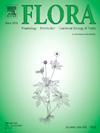瓜豆属植物的叶片和花苞片微形态因生境和习性而异。
IF 1.8
4区 生物学
Q3 ECOLOGY
引用次数: 0
摘要
竹叶微形态是确定竹种分类学位置的重要工具。新热带木本竹亚部落Guaduinae的成员,包括Guadua,是不寻常的,因为大多数在叶子表面都有气孔。生活在热带稀树草原上的瓜多的叶子也经常在两面都有乳头状突起,而这些植物有一套共同的大形态特征。我们试图从统计学上评估瓜多树叶的微形态变异模式是否与已知的栖息地或习性的大形态变异模式相一致。此外,我们还研究了番石榴花苞片的微观形态,以确定它们是否表现出与叶片相似的变异。通过对这些结构的扫描电镜图像进行分析,构建了番石榴叶片和花苞微形态特征的二值数据集,分别记录了已描述种的28种和24种,以及叶片和花苞的4种和2种推定种的微形态特征。我们利用简单匹配系数对微形态数据集生成距离矩阵,利用主坐标分析将数据可视化,并利用多因素方差分析确定基于生境和习性的叶片和花苞片微形态是否存在显著差异。结果表明,热带草原、森林和河流生境的瓜瓜,以及小拱、攀缘和大直立生境的瓜瓜,叶片和花苞片的微形态存在显著差异。本文章由计算机程序翻译,如有差异,请以英文原文为准。

Foliage leaf and floral bract micromorphology vary by habitat and habit in Guadua (Poaceae: Bambusoideae: Bambuseae)
Micromorphology of bamboo foliage leaves is a valuable tool for determining taxonomic placement of species. Members of the Neotropical woody bamboo subtribe Guaduinae, including Guadua, are unusual in that most have stomata on both leaf surfaces. Foliage leaves of savanna-dwelling Guadua also often feature papillae on both surfaces, while the plants share a suite of macromorphological characteristics. We sought to evaluate statistically whether there were patterns in micromorphological variation in Guadua foliage leaves that aligned with known habitat- or habit-based patterns in macromorphological variation. Additionally, we investigated the micromorphology of Guadua floral bracts to determine whether they displayed variation similar to that of foliage leaves. By analyzing scanning electron microscopy images of these structures, we constructed binary datasets recording presence or absence of micromorphological features on foliage leaves and floral bracts of Guadua specimens belonging to 28 and 24 described species, respectively, as well as four and two putative species, respectively, for foliage leaves and floral bracts. We produced distance matrices using simple matching coefficient for the micromorphology datasets, visualized our data using principal coordinates analysis, and determined whether there were significant differences in foliage leaf and floral bract micromorphology based on habitat and habit using factorial multivariate analyses of variance. Our results indicate that Guadua foliage leaf and floral bract micromorphology differs significantly between Guadua found in savanna, forest, or river habitats and between Guadua of small arching, climbing, or larger erect habits.
求助全文
通过发布文献求助,成功后即可免费获取论文全文。
去求助
来源期刊

Flora
生物-植物科学
CiteScore
3.30
自引率
10.50%
发文量
130
审稿时长
54 days
期刊介绍:
FLORA publishes original contributions and review articles on plant structure (morphology and anatomy), plant distribution (incl. phylogeography) and plant functional ecology (ecophysiology, population ecology and population genetics, organismic interactions, community ecology, ecosystem ecology). Manuscripts (both original and review articles) on a single topic can be compiled in Special Issues, for which suggestions are welcome.
FLORA, the scientific botanical journal with the longest uninterrupted publication sequence (since 1818), considers manuscripts in the above areas which appeal a broad scientific and international readership. Manuscripts focused on floristics and vegetation science will only be considered if they exceed the pure descriptive approach and have relevance for interpreting plant morphology, distribution or ecology. Manuscripts whose content is restricted to purely systematic and nomenclature matters, to geobotanical aspects of only local interest, to pure applications in agri-, horti- or silviculture and pharmacology, and experimental studies dealing exclusively with investigations at the cellular and subcellular level will not be accepted. Manuscripts dealing with comparative and evolutionary aspects of morphology, anatomy and development are welcome.
 求助内容:
求助内容: 应助结果提醒方式:
应助结果提醒方式:


